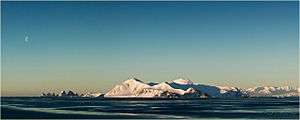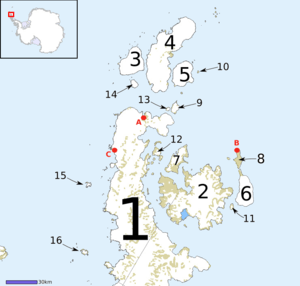Astrolabe Island
Astrolabe Island, located at 63°17′S 58°40′W, is an island 5 km (3 mi) long, lying in the Bransfield Strait 23 km (14 mi) northwest of Cape Ducorps, Trinity Peninsula in Antarctica. It was discovered by the French expedition, 1837–40, under Captain Jules Dumont d'Urville, and named by him for his chief expedition ship, the Astrolabe.[1] The island was photographed from the air and triangulated by FIDASE, 1956–57.

Astrolabe Island from northwest, with the Dragons Teeth on the left, and Drumohar Peak and Rogach Peak dominating the island.

Astrolabe Island (#15) in relation to Antarctica and other peninsula islands
Geology
Astrolabe Island is predominantly volcanic rocks, with coarse grained mafic dolerite making up most of the landing site on the east end. The steep pyramid peaks, called the Devils Teeth, may be the vents of an old volcanic complex, probably related to the Shetland subduction zone to the north.[2]
gollark: =tex 1 - \left1 - \frac{P{covid}}{P}\right^{N{gathering}}
gollark: =tex 1 - (1 - \frac{P_{covid}}{P})^{N_{gathering}}
gollark: Couldn't this just be done as `1 - ((1 - positives/population) ^ gathering)`?
gollark: Christ is his own antiparticle, so originally just Christ, not sure about the remaining one.
gollark: I would be impressed if they managed to get tracking beacons with reasonable range and battery life to actually fit.
See also
- List of Antarctic and sub-Antarctic islands
Maps
- Trinity Peninsula. Scale 1:250000 topographic map No. 5697. Institut für Angewandte Geodäsie and British Antarctic Survey, 1996.
- Antarctic Digital Database (ADD). Scale 1:250000 topographic map of Antarctica. Scientific Committee on Antarctic Research (SCAR). Since 1993, regularly upgraded and updated.
References
- Astrolabe Island. SCAR Composite Antarctic Gazetteer.
Footnotes
- "Astrolabe Island". Geographic Names Information System. United States Geological Survey. Retrieved 2012-01-19.
- Joseph Holliday, Geology Professor, El Camino College

This article is issued from Wikipedia. The text is licensed under Creative Commons - Attribution - Sharealike. Additional terms may apply for the media files.